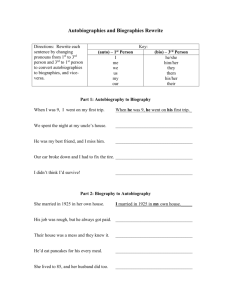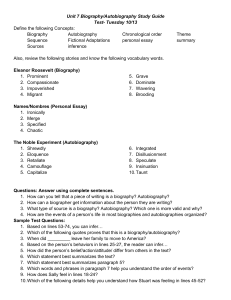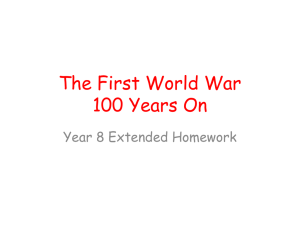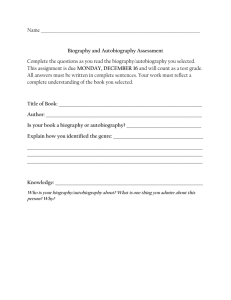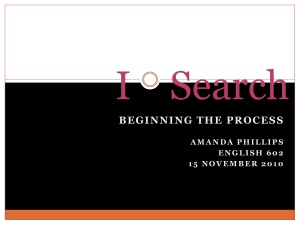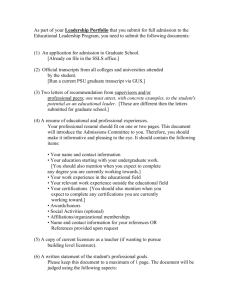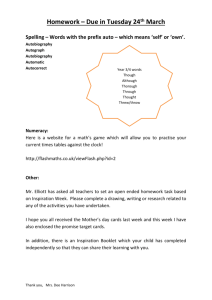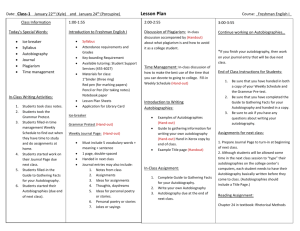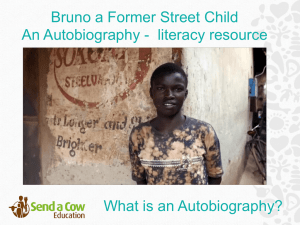Introduction to writing an autobiography
advertisement
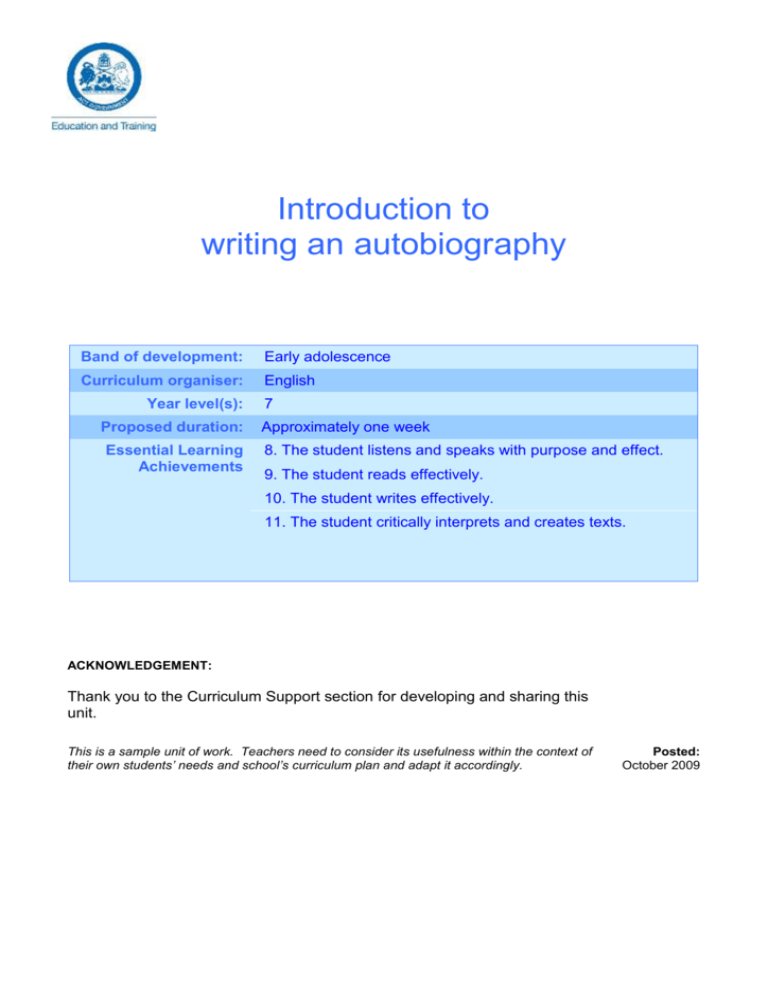
Introduction to writing an autobiography Band of development: Early adolescence Curriculum organiser: English Year level(s): Proposed duration: Essential Learning Achievements 7 Approximately one week 8. The student listens and speaks with purpose and effect. 9. The student reads effectively. 10. The student writes effectively. 11. The student critically interprets and creates texts. ACKNOWLEDGEMENT: Thank you to the Curriculum Support section for developing and sharing this unit. This is a sample unit of work. Teachers need to consider its usefulness within the context of their own students’ needs and school’s curriculum plan and adapt it accordingly. Posted: October 2009 TITLE: Introduction to a year 7 unit on writing an autobiography Band of Development: Early Adolescence Time: approx 1 week Outline of the unit The following lessons sit at the beginning of an extended unit on ‘Autobiography’ at the beginning of Year 7. As students come into the secondary school from a variety of primary schools, this unit achieves several purposes – it is part of a community building process where the students come to see the class as a learning community; it facilitates the getting-to-know each other process; it taps into prior knowledge and experiences, both academic, social and cultural. The beginning set of lessons lead into the students writing their own autobiographies as well as completing a shoebox activity (covering a shoebox with pictures, words, symbols that convey something about who they are and what they like, putting a few ‘treasures into the box, presenting the box and its contents to the class.) Students will also read a selection of other students’ autobiographies and excerpts from other autobiographies Enduring understandings: The importance of ‘my’ story and for you to respect it The importance of ‘your’ story and for me to respect it That stories are a significant part of how people and communities learn about and understand their worlds That people are different, have different stories, but all need to feel respected Plan for introductory lessons Stage 1: Desired outcomes Students will learn: what an autobiography is and the difference between autobiography and biography how writers draw on their own knowledge, experiences, thoughts and feelings timelines and family trees the difference between 1st and 3rd person narrative that both fiction and non-fiction can be written in 1st or 3rd person what is meant by 2nd person what is meant by inferring meaning/inference and perspective the origins and meanings of several words the significance of people’s stories and autobiographies Students will: discuss cooperatively in table groups, sharing ideas with the class write in sentences and paragraphs Stage 2: Evidence of learning Evidence of understanding and learning, in these introductory lessons is informal and through: noting contributions to class and group discussions (keeping a ‘kidwatching’ sheet at hand at all times) feedback from work done in groups; noting the quality of the various writing tasks, both drafts and polished versions. Stage 3: Learning plan (note, some activities can be done concurrently, and students need to be given enough time to collect family stories) Essential content to be covered during these lessons: ELA 8: The student listens and speaks with purpose and effect EA9 –provide succinct accounts of personal experiences or events and reflect on their significance ELA 9: The student reads effectively EA8 – infer meanings and messages ELA 10: The student writes effectively EA 1 – how writers draw on their own knowledge and experiences EA12 – write in paragraphs to order and sequence information EA 17 – revise and edit writing EA 11: The student critically interprets and creates texts EA8 – the ways language can be adjusted to show or acknowledge power and to indicate closeness or distance in relationships Engaging students in the area of study connections between past and present learning experiences Opening discussions around the following questions: Has anyone written or read an autobiography? What is an autobiography? Who knows what a family tree is? Who knows what a timeline is? Can someone draw an example of a timeline on the board? Does your family tell stories about what people in your family have done? As students respond, have a couple of them act as scribes noting some ideas the whiteboard. As much as possible, draw on several students across the range of cultural backgrounds for answers to the questions. Allow time for a couple of stories for the whole class, or sharing of stories at table. Activity: In your workbooks write down 6 sentences about what you have done today so far, from the time you woke up. Swap books with your neighbour. Read what has been written and then write the same ‘story’ as if you were writing a story about your neighbour’s morning and what he or she has done, e.g. This morning Damon work up when his dog jumped on his bed …. At your tables discuss what are the differences in the 2 stories each of you now has in your book. A call-out session: notes on the board – draw out main points about 1st and 3rd person writing (clarify 2nd person), differences in perspective. At your tables, sharing a dictionary between 2 people, look up the 2 words on the board – biography and autobiography. Ask a student to read out each definition. Discussion and clarification Exploring related concepts (a) language underpinning the concepts of biography and autobiography; (b) implications of the differences What is the connection between the writing exercise you have done and these definitions? Look again at the definitions: biography: where does the word come from? autobiography: how has this word developed? look up also – graph, graphic, graphite. What is the basic idea in these words? After a call-out of ideas, put up a prepared chart, in a ‘Interesting things about Language’ section of board in the classroom(to be added to regularly throughout the year), with the following on it: auto: from the Greek autos – self bio: from the Greek bios – life graphy: from the Greek graphein – to write Give out sheet with 2 short stories written on it about a neardrowning incident – a toddler falling into a pond while at a family picnic. The first account is by the mother; the second by a local newspaper reporter. Question on the board – what is the difference between someone telling their own story and someone else telling the story? between the two genres At table groups, on butcher’s paper, brainwave about: a) what are the differences? b) what might be the advantages of each type of writing? c) what might be the limitations of each type of writing? Before starting the activity, ask students how they might write down their ideas/organise their ideas – e.g. list under the 3 questions, maybe in 3 columns; find out if any have done mind-mapping or concept mapping – use whatever knowledge is there for a start (but will do more about this later in the year). While students are working, draw 2 circles on the whiteboard, each with 2 lines pointing to the words – advantages, limitations. Draw a line above each for the headings ‘autobiography’ and ‘biography’. Autobiography Someone writing about him/ herself Advantages Pulling Advantages Limitations Biography Someone writing about another person Limitations From the feedback from the groups fill in the relevant information on the diagram on the board, drawing out the ideas about threads together Further exploration through a writing activity Revising paragraph writing Visiting family trees and timelines Stories from home Writing your different perspectives if you are writing about yourself than if someone is writing about you what is the difference between a novel written in 1st person and an autobiography what we mean by inferring meaning (actions may imply a meaning etc – give basic example of someone slamming a door. Seek other examples.) Introduce the word ‘genres’ by asking if anyone has heard of it. Write the word on the board and get students to look it up in the dictionary. Ask a student to add it to the language section of the board. Use the word from now on when talking about different kinds of writing/literature. Hand out newspaper clippings of various social, sporting and local community news reports (reflecting a wide range of interest and background). Students should choose 1 and re-write it in an autobiographical form as one of the people in the report telling their own story. The story should only be 2 or 3 paragraphs. Look again at the advantages and limitations of the 1st person and 3rd person narrative. Use the scaffold of a paragraph having: a topic sentence a developing sentence supporting sentences concluding sentence In the story they wrote as a piece of autobiography how did they go with their paragraphs. Ask them to check and choose 1 paragraph to rewrite and improve. Ask if anyone has a family member who is interested in, has done or is doing a family tree. What is a family tree? Put up overhead/find an example on the internet, of a 4 generation family tree (and one with a few deaths, a remarriage, and child born earlier than his/her uncle/aunt, so being older than the uncle or aunt). In pairs, students answer a few questions about who is who, who is older or younger, who is someone’s aunty etc. If possible get students onto the internet, google examples of family trees. Through a call out of answers clarify any misunderstandings about how to ‘read’ dates e.g a person born in 1989 is younger than a person born in 1973. Move on to timelines, relate to history AD and BC/ Common Era Again clarify issues such as 10 BC being more recent than 100 BC and so on. Look at a timeline for Australia – the millions of years before habitation, the thousands of years of indigenous inhabitation, the very recent arrival of Europeans. Use also the serpent depiction of Australia’s timeline. Students to ask a family member to tell them a story about their lives (a significant incident perhaps, or a funny one) – when they come to class they recount the story to their table group. Why are people’s stories and autobiographies important? With a callout and class discussion make points e.g. about history, primary sources, secondary sources, the importance of oral history, how different cultures ‘tell’ their stories. The unit continues from this point with the class deciding on what autobiography should be included in an autobiography There will be choice so that students can pursue some aspects in more detail (or perhaps avoid painful areas if need be). There will be some reading of excerpts from autobiographies and consideration of sources of information.
